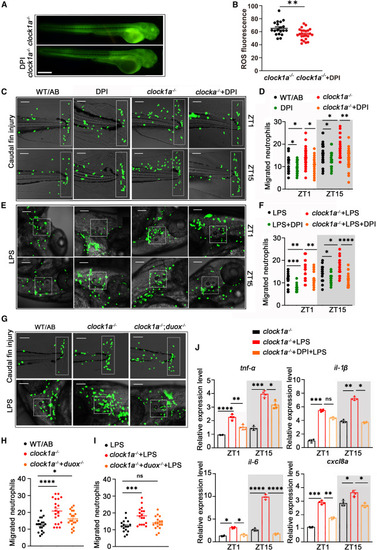Fig. 6
- ID
- ZDB-FIG-240205-36
- Publication
- Chen et al., 2023 - Circadian clock1a coordinates neutrophil recruitment via nfe212a/duox-reactive oxygen species pathway in zebrafish
- Other Figures
- All Figure Page
- Back to All Figure Page
|
ROSs participate in the rhythmic regulation of neutrophil recruitment by Clock1a (A and B) Fluorescence staining showed that DPI treatment significantly inhibited ROS production (n = 20). Scale bar: 50 μm. Data were analyzed with unpaired t tests. (C and D) In the fin damage model, DPI treatment significantly suppressed the increased neutrophil recruitment due to clock1a mutation at both ZT1 and ZT15 (n = 20). Scale bar: 10 μm. Data were analyzed with one-way ANOVA. (E and F) In the LPS injection model, DPI treatment also significantly suppressed the increased neutrophil migration caused by clock1a mutation at both ZT1 and ZT15 (n = 20). Scale bar: 5 μm. Data were analyzed with one-way ANOVA. (G) The clock1a−/−;duox−/− mutant was obtained by crossing the clock1a and duox mutants. Scale bar: 10 μm. (H and I) The duox mutation was found to reverse the increased neutrophil migration caused by the clock1a mutation to some extent in both (H) caudal fin injury and (I) LPS challenge models at both ZT1 and ZT15 (n = 20). Scale bar: 6 μm. Data were analyzed with one-way ANOVA. (J) DPI treatment significantly downregulated the clock1a-mutation-induced increase in cytokine expression at both ZT1 and ZT15. Data were analyzed with one-way ANOVA. All experiments were repeated three times, and the results show the data from an independent experiment. Bar graphs represent the mean ± SEM (∗p < 0.05; ∗∗p < 0.01; ∗∗∗p < 0.001). |

